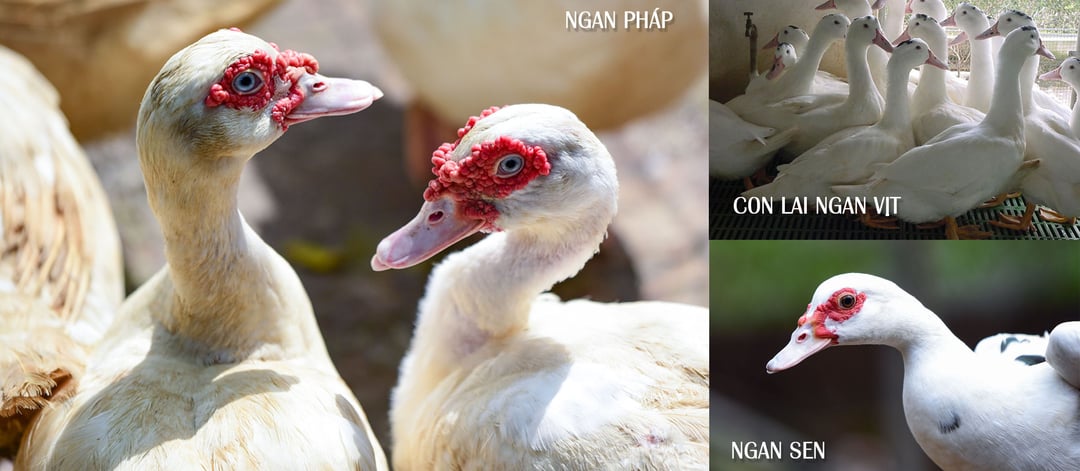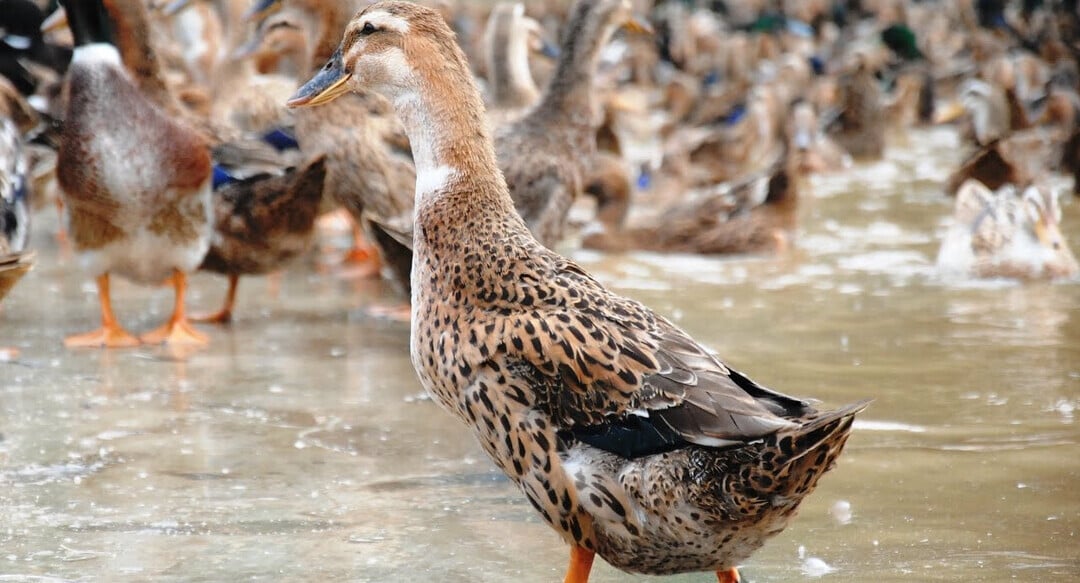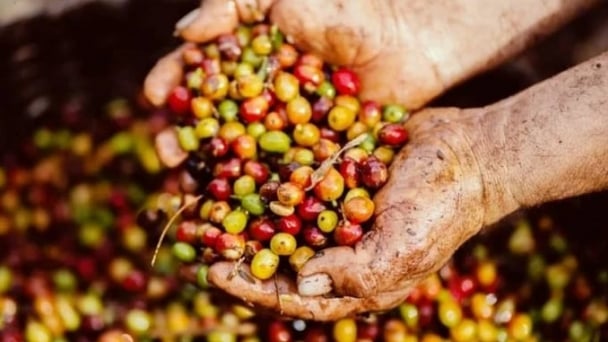June 18, 2025 | 06:39 GMT +7
June 18, 2025 | 06:39 GMT +7
Hotline: 0913.378.918
June 18, 2025 | 06:39 GMT +7
Hotline: 0913.378.918
Dai Xuyen Duck Breeding and Research Center and a number of units under the National Institute of Animal Science (NIAS) are storing most of the best imported and domestic duck breeds in Vietnam today in terms of productivity, quality and adaptability.
This duck breed is also known as Cherry Valley duck or Anh Dao duck. It is a high-yielding industrial duck breed created by Cherry Valley Farms Ltd., UK in 1976, and brought back to Vietnam in the late 1990s.
Super M duck has white fur, a pale yellow bill and legs. Parent ducks have a laying age of 25 weeks, in-birth body weight of 3.2 - 3.4 kg/head, egg yield of 180 - 220 eggs/67 weeks of age, and feed consumption/10 eggs of 3.9 - 4.2kg.
Commercial ducks raised for 47 - 49 days reach a weight of 3.4 - 3.6 kg/head, consuming 2.2 - 2.4 kg of feed/kg of weight gain. Super M duck is also used as a base for artificial insemination with male geese to create a duck-geese hybrid.
Super M duck line and Star duck line.

Super M duck line and Star duck line.
Star duck is a breed of duck that belongs to the family of super meat ducks researched, selected, created and introduced into Vietnam by the French firm named Grimaud Freres Selection. Grimaud Star duck has the highest proportion of breast meat and breast muscle in the world today.
Star duck has white feathers, pale yellow bill and legs. Parent ducks have a laying age of 24 weeks, in-birth weight of 3.1 - 3.3 kg/head, egg yield of 180 - 210 eggs/66 weeks of age, and feed consumption/10 eggs of 3.9 - 4.2kg.
Commercial ducks raised for 45 - 47 days reach a weight of 3.2 - 3.5 kg/head, consuming 2.35 - 2.45 kg of feed/kg of weight gain. This duck breed is very suitable for industrial-scale farming and barn rearing.
French White Muscovy duck parents have a laying age of 26 - 28 weeks, egg yield of 160 - 190 eggs/hen/year. Commercial Muscovy ducks reach a weight of 3.0-3.5kg/female at 10 weeks of age, 5.0-6.5kg/male at 12 weeks of age, consuming 2.5 - 2.7kg of feed/kg of weight gain.

French White Muscovy ducks, Sen Muscovy duck, and Duck/Muscovy duck hybrid.
Sen Muscovy duck’s origin is derived from domestic grass Muscovy duck. The Sen Muscovy duck breed was selected and bred by Dai Xuyen Duck Breeding and Research Center to gain more weight but still retain the delicious meat quality.
Sen Muscovy duck parents have a laying age of 28-30 weeks, egg yield of 70-85 eggs/hen/year. Commercial geese reach a weight of 2.0-2.5kg/female at 10 weeks of age, 3.0-3.5kg/male at 12 weeks of age, consuming 2.8 - 3.0kg of feed/kg of weight gain.
The Duck/Muscovy duck hybrid was created when crossing a French White Muscovy duck with a Super M duck using artificial insemination technology.
The Duck/Muscovy duck hybrid has high vitality can be grown commercially up to 63 days old. Its weight can reach 3.6 - 4.0kg/head, consuming 2.6 - 2.75kg of feed/kg of weight gain, the meat is as dark as Muscovy duck meat and as savory as duck meat.
Gray goose spawning parents have a calving age of 30-32 weeks, egg yield of 80-90 eggs/hen/year. Commercial gray geese reach a weight of 6.0 - 6.5 kg/female at 16 weeks of age, 6.0 - 8.0 kg/male at 16 weeks of age, consuming 3.5 - 4.0 kg of feed/kg weight gain.
Sea duck 15 is being raised at the Dai Xuyen Duck Research Center. This breed has dark sparrow-colored feathers, pale yellow bill and legs. Salt water areas such as coastal areas, islands, and estuaries are the most suitable raising environment for sea duck 15. And it is also possible to raise this breed in freshwater conditions.
This duck breed has a laying age of 20 - 21 weeks, egg yield of 235 - 245 eggs/hen/year with each egg weighing 79 - 85 g. Commercial ducks 50 - 55 days old can reach a weight of 2.6 - 2.9 kg/head, consuming 2.3 - 2.5 kg of feed/kg of weight gain.
The multi-purpose Dai Xuyen PT duck has pale sparrow-colored feathers, pale yellow bill and legs. Dai Xuyen Pt duck is suitable for keeping in captivity in controlled zoned fields.
This breed has a laying age of 21 - 22 weeks, egg yield of 220 - 230 eggs/hen/year with each egg weighing 78 - 84 g. Commercial ducks up to 55 days old can reach a weight of 2.7 - 2.9 kg/head, consuming 2.3 - 2.5 kg of feed/kg of weight gain.
This domestic duck breed originated in Ben Market, Lac Son district, Hoa Binh province. its feather’s color is mainly sparrow-like, and there are some more colors such as gray, splattered black-white, and even black-pure white. Bau Ben duck has high adaptability to traditional farming conditions.
Bau Ben duck parents have a laying age of 22 - 23 weeks old, egg yield of 150 - 160 eggs/hen/year with each egg weighing 70 - 75g. Commercial ducks 70 days old gained can reach a weight of 1.5 - 1.8 kg/head.
Bau Minh Huong duck, also known as stream duck, is an indigenous breed of duck that has existed for a long time in Minh Huong commune, Ham Yen district, Tuyen Quang province. This breed can grow and develop well in harsh conditions.
Bau Minh Huong duck also has a short beak, wings, and legs with a uniform yellow color. The male has a green coat under the wings and neck. Bau Minh Huong duck weighs 1.8 - 2 kg when reaching adulthood.
This breed has a laying age of 23 - 26 weeks and egg yield of 80 eggs/hen/20 weeks of laying with each egg weighing 70 - 80 g. Commercial ducks can reach a weight of 22.2 - 2.4 kg for male ducks and 2.0 - 2.2 kg for female ducks. The consumption rate per 10 eggs is 4.0- 4.5 kg of feed/kg of weight gain.
Bau Quy duck has long been known as the number one product in Western Nghe An. This is a waterfowl breed originating in the land of Quy Chau, Que Phong. In addition to nutritional value, Bau Quy duck also possesses rare genetic resources.
Bau Quy duck has a big head, short neck and legs, and belly almost touching the ground. An adult duck weighs only 1.5 - 1.8 kg.
Raising Bau Quy ducks is not too difficult. They often find their own food in streams, so farmers only need to add rice and grains during the egg laying period. In adulthood, Bau Quy duck weighs 2.2-2.5 kg for male ducks and 2.0-2.2 kg for female ducks. Bau Quy duck begins to lay eggs after 6 months old with each egg weighing 50-60g.
Co Lung duck, also known as Quoc Thanh duck or Muong Khuong duck is an indigenous breed of duck originating in Co Lung commune, Ba Thuoc district, Thanh Hoa. Co Lung duck is a rare breed of duck, a long-standing genetic breed that many generations of Ba Thuoc people preserved and developed. Co Lung duck is recognized by the government of Vietnam as a domestic animal breed that is allowed to be produced, traded and circulated within the Vietnamese territory.
Co Lung duck has its own signature characteristics that are considered to be peculiar to this breed: short neck, small and short legs, the neck and head covered with feathers and smooth feathers, the male duck has curly tail feathers and blue neck feathers with a pearlescent sheen. Co Lung duck is raised for approximately 6 months to start laying eggs. Its weight can reach 1.6-1.7 kg when the duck is 3-4 months old, and 1.5-2 kg after 4 to 5 months of rearing.

The diversity of Vietnam's multi-purpose duck breeds.
This breed of duck has its root in Lang Son province, where the ethnic people usually call it "Pat Lai”. Pat Lai duck has high adaptability to traditional farming conditions.
Pat Lai duck has light sparrow-colored feathers. The ducks are of medium size, and commercial ducks weigh from 1.8 to 1.9 kg/head. Breeding ducks have a laying age of 22 - 23 weeks, egg yield of 150 - 180 eggs/hen/year with each egg weighing 65 – 70 g.
Ky Lua duck is a domestic breed originating in Lang Son province. Ky Lua duck is widely raised in the northern midland and mountainous provinces. Ky Lua ducks are well-adapted to cold winters and harsh rearing conditions, have high herd compatibility and can be grazed in fields and yards.
Ky Lua ducks lay eggs relatively early, after 150 - 160 days old when the ducks weigh 1.7 - 1.9 kg. Egg production is 110 - 130 eggs/hen/year with each egg weighing 70 – 75 g. Ky Lua duck’s eggs hatch after 28 days of incubation. The average body weight of commercial ducks at 63 days old is 1.2 - 1.6 kg. At maturity the male weighs 2.8 - 3.0 kg and the female weighs 2.2 - 2.5 kg.
Sin Cheng duck possesses a source of indigenous livestock genes dating from a long time ago in Sin Cheng commune, Si Ma Cai district, Lao Cai province. This is a precious gene that the Ministry of Agriculture and Rural Development and the Ministry of Science and Technology have chosen for preservation and put on the list for exploitation and economic development in this locality.
Sin Cheng duck has an average weight of 1.5-2kg/head, sweet meat. It has a continuous egg-laying cycle of approximately three months, the eggs are large and have a high yolk ratio. Sin Cheng ducks have good vitality, less affected by epidemics, diseases and harm. But the total herd of Sin Cheng ducks in Si Ma Cai district is only more than 6,000 at present.
Indian spot-billed duck is small in stature, has a narrow body, yellow-black bill and legs, and its eyes have a gray tail streak.
Breeding ducks have a laying age of 23 - 24 weeks, egg yield of 200 - 210 eggs/hen/year with each egg weighing 45 - 50 g. Commercial ducks raised to 70 days old weighs from 0.9 to 1.2 kg/head, consuming 4.2 - 4.5 kg of feed/kg of weight gain, helping farmers gain a profit of VND 50 - 80,000/head.
Hoa Lan ducks originated in Europe and were imported to Vietnam a few decades ago. This duck breed is well adapted to the Mekong Delta provinces, especially adaptive to saline water conditions. The main breeding method suitable for Hoa Lan ducks is grazing combined with captive breeding.
At 16 weeks of age, Hoa Lan duck’s average survival rate is 93% and the average weight of male and female ducks was 1.644 and 1.547 kg/head respectively. The average laying rate is 53%/year with egg yield of 195 eggs/hen. The percentage of eggs with embryos is 82% and the hatching rate/total number of eggs is 71%.

The total herd of Sin Cheng ducks in Si Ma Cai district is only more than 6,000 at present.
Dai Xuyen TC super egg duck has dark color feathers, pale yellow beak and legs. The parent ducks have a laying age of 17-18 weeks old, weight of 1.2 - 1.4 kg/head, egg yield from 275 to 290 eggs/hen/year with each egg weighing 68 – 70 g, and a consumption rate per 10 eggs of 1.9 - 2.05 kg of feed.
BT ducks have sparrow-colored feathers. The parent ducks have a laying age of 20 - 22 weeks old, body weight of 1.6 - 1.7 kg/head, egg yield of 275 - 285 eggs/hen/year with each egg weighing 70 - 75g, and a consumption rate per10 eggs of 2.0 - 2.3 kg of feed/kg of weigh gain.
Triet Giang super egg duck has pale yellow feathers, bill and legs. The parent ducks have a laying age of 16 - 17 weeks old, body weight of 1.1 - 1.3 kg/head, egg yield of 260 - 270 fruit/hen/year with each egg weighing 55 – 65 g, and a consumption rate per 10 eggs of 2.0 - 2.15 kg of feed.
Super brown duck TsN 15 - Dai Xuyen is an egg-specialized duck breed. The ducks have brown feathers, pale yellow bills and legs. The parent ducks have a laying age of 18-19 weeks old, body weight of 1.2 - 1.4 kg/head, egg yield of 260 - 270 eggs/hen/year with each egg weighing 60 – 68 g, and a consumption per 10 eggs of 1.95 - 2.10 kg of feed.
Sparrow-colored grass duck is a breed of duck specialized in eggs. This breed is selected from the many grass duck breeds of Vietnam. The parent ducks have a laying age of 20 - 21 weeks, body weight at laying period of 1.3 - 1.6 kg/head, egg yield of 250 - 260 eggs/hen/year with each egg weighing 63 - 67g, and a consumption rate per10 eggs of 2.0 - 2.1 kg of feed.

Dai Xuyen TC super egg duck, BT duck, Triet Giang super egg duck, Super brown duck TsN 15 - Dai Xuyen, and Sparrow-colored grass duck.
Translated by Samuel Pham
![Turning wind and rain into action: [7] Early disaster warnings help marine farmers minimize losses](https://t.ex-cdn.com/nongnghiepmoitruong.vn/608w/files/news/2025/06/17/z6704423696987_15fd32ffc26d590d204d520c9dac6786-nongnghiep-142942.jpg)
(VAN) In recent years, thanks to early disaster warnings and forecasting, marine farmers in Khanh Hoa province have been able to reduce risks and losses, thereby improving production efficiency.
![Turning wind and rain into action: [6] ‘Four on-the-spot’ disaster management software](https://t.ex-cdn.com/nongnghiepmoitruong.vn/608w/files/news/2025/06/17/e5a48259d6a262fc3bb3-nongnghiep-183800.jpg)
(VAN) By simply activating the scenario on the disaster management software, the relevant authorities immediately know how many households need to be evacuated, where to evacuate them to, and by what means of transportation…
![Turning wind and rain into action: [5] Hue applies modern technology in disaster forecasting](https://t.ex-cdn.com/nongnghiepmoitruong.vn/608w/files/news/2025/06/17/z6704423696987_15fd32ffc26d590d204d520c9dac6786-nongnghiep-093938.jpg)
(VAN) In Hue city, modern technology has recently been applied in meteorological and hydrological forecasting and warning, helping to reduce the damage caused by natural disasters.

(VAN) A cutting-edge farming technique being implemented on an experimental ranch in Arizona's Sonoran Desert has already saved a billion gallons of water over five years, according to Civil Eats.

(VAN) Poultry and pig production and the environment can be boosted through enhanced water technology, according to new research.

(VAN) Coffee prices on June 16, 2025 are unchanged. In Vietnam, local trading prices are holding steady, ranging around VND 112,000 – VND 112,500/kg.
![Turning wind and rain into action: [4] Bringing climate bulletins to remote and isolated areas](https://t.ex-cdn.com/nongnghiepmoitruong.vn/608w/files/linhnhp/2025/06/14/1152-z6704423696987_15fd32ffc26d590d204d520c9dac6786-nongnghiep-151141.jpg)
(VAN) The Vietnam Agriculture and Nature Newspaper interviewed Mr. Vu Thai Truong, Acting Head of Climate Change and Environment at UNDP Vietnam, to gain deeper insight into how climate bulletins are delivered to farmers.